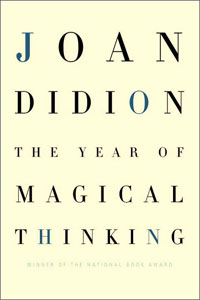Book Notes
 Joan Didion, The Year of Magical Thinking (New York: Knopf, 2005), 227pp.
Joan Didion, The Year of Magical Thinking (New York: Knopf, 2005), 227pp.
Into the unremarkable routines of our lives explodes the unthinkable, the incomprehensible. At nine o'clock one evening Joan Didion and her husband John Gregory Dunne sat down to dinner in the living room of their New York City apartment. They had just returned from the hospital where they had visited their only child Quintana, who five days earlier was admitted to the hospital for septic shock and was put on life support after an induced coma. John talked about World War One. He asked Joan for a second drink of Scotch. He then raised his left hand and slumped over dead from a massive heart attack. A few days later at her computer Didion wrote,
Life changes fast.
Life changes in the instant.
You sit down to dinner and life as you know it ends.
The Year of Magical Thinking, writes Didion, "is my attempt to make sense of the period that followed, weeks and then months that cut loose any fixed idea I had ever had about death, about illness, about probability and luck, about good fortune and bad, about marriage and children and memory, about grief, about the ways in which people do and do not deal with the fact that life ends, about the shallowness of sanity, about life itself."
As writers Didion and Dunne had worked at home together almost every day during forty years of marriage. In the space of a few seconds all that ended. By "magical thinking" Didion means the paroxysms of disbelief, denial, and derangement that expressed themselves in any number of irrationalities in the months that followed John's abrupt death. She tried to reconstruct a time line of events. She read medical and psychological literature to understand death itself and her grieving process. She describes her efforts to "bring him back," and her feelings of isolation, rage, helplessness, vulnerability, and self-pity. After a year (when she started to write this book), she says, the craziness ended, but neither clarity nor resolution followed. She discovered that she did not believe the creeds she learned growing up in the Episcopal church, or in the resurrection of the dead. Nor had John. In the last four sentences of the book, Didion compares her experience to memories of swimming in the ocean. "You had to feel the swell change. You had to go with the change. He told me that. No eye is on the sparrow but he did tell me that." The New York Times identified Didion's book as one of the five most notable books of non-fiction for 2005, and no doubt it will take its place alongside other classics on bereavement such as A Grief Observed by CS Lewis.


